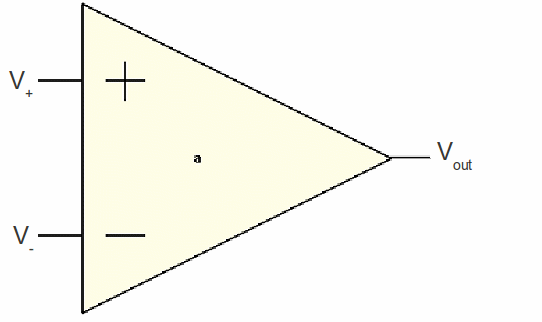Operational amplifiers are linear devices that have all the properties required for nearly ideal DC Voltage amplification, used extensively in signaling circuits, filtering or to perform mathematical operations such as addition and subtraction.. An ideal operational amplifier is basically a three-terminal device which consists of two high impedance inputs, one called the inverting Input, marked with a negative sign, ("-") and the other one called the non-inverting Input, marked with a positive plus sign ("+").

In a linear operational amplifier, the difference between the input voltages![]() and
and![]() is amplified
is amplified
by the factor![]() the open loop gain of the amplifier.
the open loop gain of the amplifier.
![]()
where![]() is the voltage at the non-inverting terminal and
is the voltage at the non-inverting terminal and![]() is the voltage at the inverting terminal.
is the voltage at the inverting terminal.
The magnitude of![]() is typically very large—10,000 or more for integrated circuit op-amps—and therefore even a quite small difference between
is typically very large—10,000 or more for integrated circuit op-amps—and therefore even a quite small difference between![]() and
and![]() can push up the amplifier output nearly to the supply voltage. This is called saturation of the amplifier. The magnitude of
can push up the amplifier output nearly to the supply voltage. This is called saturation of the amplifier. The magnitude of![]() is not well controlled by the manufacturing process, and so it is impractical to use an operational amplifier as a stand-alone differential amplifier. If predictable operation is desired, negative feedback is used, by applying a portion of the output voltage to the inverting input. The closed loop feedback greatly reduces the gain of the amplifier. If negative feedback is used, the circuit's overall gain and other parameters become determined more by the feedback network than by the op-amp itself. If the feedback network is made of components with relatively constant, stable values, the unpredictability and inconstancy of the op-amp's parameters do not seriously affect the circuit's performance.
is not well controlled by the manufacturing process, and so it is impractical to use an operational amplifier as a stand-alone differential amplifier. If predictable operation is desired, negative feedback is used, by applying a portion of the output voltage to the inverting input. The closed loop feedback greatly reduces the gain of the amplifier. If negative feedback is used, the circuit's overall gain and other parameters become determined more by the feedback network than by the op-amp itself. If the feedback network is made of components with relatively constant, stable values, the unpredictability and inconstancy of the op-amp's parameters do not seriously affect the circuit's performance.
If no negative feedback is used, the op-amp functions as a switch or comparator.
Positive feedback may be used to introduce hysteresis or oscillation.
